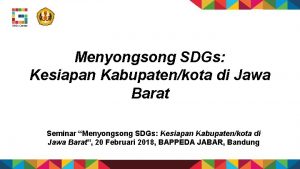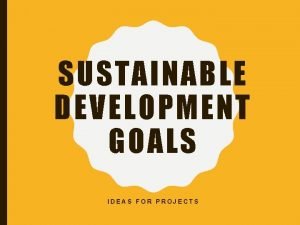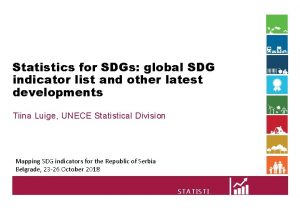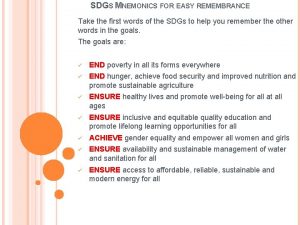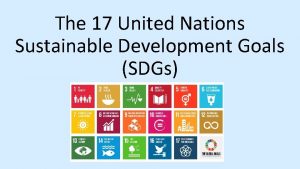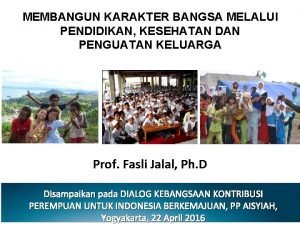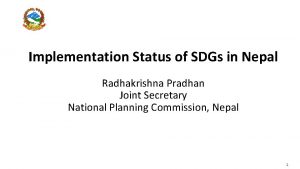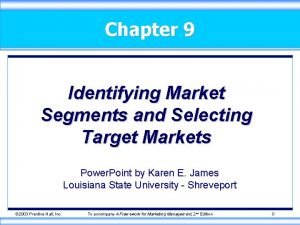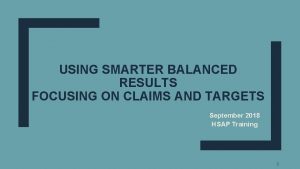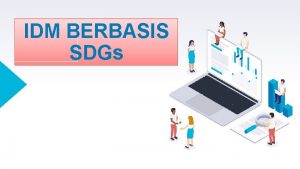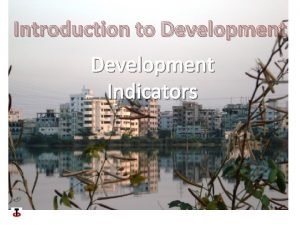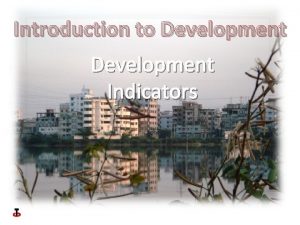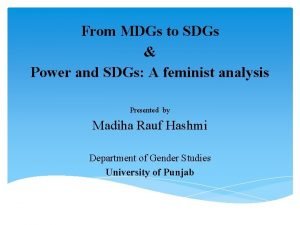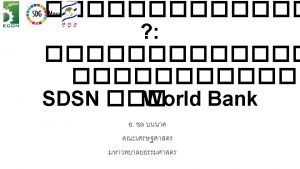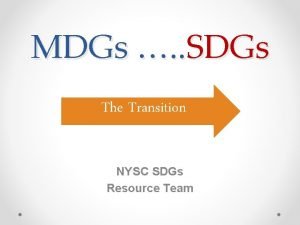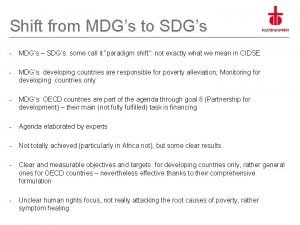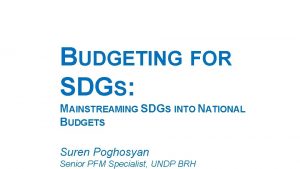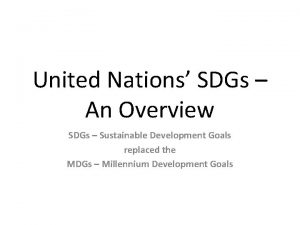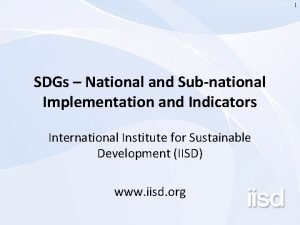Session 2 SDGs Targets and Indicators SDGs targets

















- Slides: 17

Session 2: SDGs, Targets and Indicators SDGs, targets and global indicator framework: The What, Who, and How The role of the UN Big Data for Official Statistics and it’s Global Working Group Dr Arnold Dekker | Earth Observation Informatics FSP GEO PLENARY XII SIDE EVENT SUSTAINABLE DEVELOPMENT GOALS: EARTH OBSERVATIONS IN SERVICE OF GLOBAL DEVELOPMENT 10 November 2015 Mexico City EARTH OBSERVATION INFORMATICS FUTURE SCIENCE PLATFORM

Big. Data UN GWG Met in Abu Dhabi 19 th November 2015 GEO UN SDG Side Event 10 th Nov 2015, Mexico City

The Big Data UN GWG acknowledged that “using Big Data for official statistics is an obligation for the statistical community based on the Fundamental Principle to meet the expectation of society for enhanced products and improved and more efficient ways of working. ”. The GWG established 8 task teams to implement its mandate on the topics of • “Advocacy and communication“ • “Linking Big Data and the Sustainable Development Goals“ • "Access and Partnerships“ • "Training, Skills and Capacity building“ • "Cross-cutting issues“ • "Mobile phone data“ • "Satellite imagery“ • "Social media data". • Members: Australia, Bangladesh, Cameroon, China, Colombia, Denmark, Egypt, Indonesia, Italy, Mexico, Morocco, Netherlands, Oman, Pakistan, Philippines, Tanzania, UAE, USA, UNSD, UNECE, UNESCAP, UN Global Pulse, ITU, OECD, World Bank, Eurostat, GCC-stat • Partners: Positium, University of Pennsylvania GEO UN SDG Side Event 10 th Nov 2015, Mexico City

The Big Data UN GWG acknowledged that “using Big Data for official statistics is an obligation for the statistical community based on the Fundamental Principle to meet the expectation of society for enhanced products and improved and more efficient ways of working. ”. The GWG established 8 task teams to implement its mandate on the topics of • “Advocacy and communication“ • “Linking Big Data and the Sustainable Development Goals“ • "Access and Partnerships“ • "Training, Skills and Capacity building“ • "Cross-cutting issues“ • "Mobile phone data“ • "Satellite imagery“ • "Social media data". • Members: Australia, Bangladesh, Cameroon, China, Colombia, Denmark, Egypt, Indonesia, Italy, Mexico, Morocco, Netherlands, Oman, Pakistan, Philippines, Tanzania, UAE, USA, UNSD, UNECE, UNESCAP, UN Global Pulse, ITU, OECD, World Bank, Eurostat, GCC-stat • Partners: Positium, University of Pennsylvania GEO UN SDG Side Event 10 th Nov 2015, Mexico City

The 2030 Agenda for Sustainable Development 17 goals, 169 targets, hundreds of indicators • Universally applicable, taking into consideration domestic priorities / policies • Countries need to develop strategies and plans for reporting at national, regional, global levels. 5

The 2030 Agenda for Sustainable Development 17 goals, 169 targets, hundreds of indicators EO EO • Universally applicable, taking into consideration domestic priorities / policies • Countries need to develop strategies and plans for reporting at national, regional, global levels. 6

GEO UN SDG Side Event 10 th Nov 2015, Mexico City

GEO UN SDG Side Event 10 th Nov 2015, Mexico City

A main conclusion was that there needs to be more dialogue between the CEOS and GEO and related communities and the UN SD & UN GGIM etc. , and National Statistics Offices for the geospatial SDG relevant information that satellite imagery may provide now and in the future GEO UN SDG Side Event 10 th Nov 2015, Mexico City

Earth Observing Sensors are getting more sophisticated and map much more variables at higher frequency More physical characteristics measured from space: 1. Visible light and nearby infrared reflectance and emittance (e. g. Fluorescence) from multispectral to hyperspectral 2. Short Wave Infrared reflectance; multiple spectral bands 3. Thermal Infrared Reflectance and emittance: multiple thermal bands 4. Microwave - active : more radar bands (C, X, L, S band) more polarisations 5. Microwave – passive: soil moisture and ocean salinity-increased spatial resolution 6. Altimetry: increased spatial resolution 7. LIDAR and Altimetry(Laser and radar altimetry from space resp. )) 8. Gravimetry anomaly detection ( groundwater aquifer depletion and recharge) GEO UN SDG Side Event 10 th Nov 2015, Mexico City

Earth Observing Sensors are getting more sophisticated and map much more variables at higher frequency More physical characteristics measured from space: 1. Visible light and nearby infrared reflectance and emittance (e. g. Fluorescence) from multispectral to hyperspectral: only data used by GWG Big Data Official Stats 2. Short Wave Infrared reflectance; multiple spectral bands 3. Thermal Infrared Reflectance and emittance: multiple thermal bands: only data used by GWG Big Data Official Stats 4. Microwave - active : more radar bands (C, X, L, S band) more polarisations 5. Microwave – passive: soil moisture and ocean salinity-increased spatial resolution 6. Altimetry: increased spatial resolution 7. LIDAR and Altimetry(Laser and radar altimetry from space resp. )) 8. Gravimetry anomaly detection ( groundwater aquifer depletion and recharge) GEO UN SDG Side Event 10 th Nov 2015, Mexico City

CEOS and GEOSS are actively considering their response to SDGs Indicators and targets CEOS 31 Space Agencies 24 Associates Space Arm Of 97 governments & EU 87 organizations GEO UN SDG Side Event 10 th Nov 2015, Mexico City GEOSS

GEO Initiative on SDGs Candidate GEO Initiative for GEO 2016 Work Program Draft GEO 2016 Work Program contains a candidate GEO initiative for SDGs = GI-18 : GEO and SDGs. GEO role in defining the indicators and providing support to countries in measuring, monitoring and achieving the SDGs. Goals: 1) To engage with Member States, the UN Statistics Division and other partners in the development/refinement of the indicators supporting the SDG Goals and Targets to be approved by the UN Statistical Commission in March 2016. 2) Develop pilot projects in one or more GEO Member countries focused on integrating Earth observations with national statistical accounts to better measure, monitor and achieve the SDGs. 13

Summary and CEOS Engagement Opportunities • Work with GEO to formulate pilot projects in selected countries to demonstrate SDG indicator monitoring with satellite EO. • Develop a strategy and messages to facilitate consistent communication within national institutional ecosystems in support of the significant implementation challenge national statistical offices will face. • Analyse how space-based EO can support the implementation of the indicators • Develop capacity building strategy and material, in support of the significant implementation challenge national statistical offices will face 14

United Nations Statistical Commission -Global Working Group on Big Data for Official Statistics -2 nd Meeting, 19 Oct 2015, Abu Dhabi, United Arab Emirates & 2 nd UN Global Conference on Big Data for Official Statistics 20 &21 Oct 2015 (invitation only) Big Data incl. Satellite Imagery http: //unstats. un. org/unsd/trade/events/2015/abudhabi/gwg-agenda. asp. http: //unstats. un. org/unsd/trade/events/2015/abudhabi/default. asp). Australian Bureau of Statistics leads the Task Team on Satellite Imagery, Geospatial Data and Remote Sensing. t f a r D • Global Working Group on Big Data for Official Statistics organising the 3 rd Global Conference on Big Data for Official Statistics 28 to 30 June 2016 in Dublin, Ireland Ideas: Increase target audience & add exhibition booths where the statistical community, but also private sector and civil society could show what they are doing. = possible CEOS & GEO opportunity! r D t af

GEO PLENARY XII SIDE EVENT: SUSTAINABLE DEVELOPMENT GOALS: EARTH OBSERVATIONS IN SERVICE OF GLOBAL DEVELOPMENT. November 10, 2015 Mexico City Some Side Event Objectives & Discussion Topics (adapted by A. G. Dekker with both a CEOS and GEO hat on) • The development, reporting and tracking of robust indicators • Identify pathways for Earth observations to support SDG goals, targets and indicators • Lessons learned from similar efforts using Earth observations to develop and implement policy-relevant indicators • Reach agreement on establishing a partnership between CEOS and GEO and SDG stakeholders • Make concrete refinements to a dedicated CEOS and GEO initiative on the SDGs, addressing both CEOS and GEO contributions overall and GEO support to countries on SDG tracking and reporting • Support and guide the UN Big Data for Official Statistics and it’s Global Working Group to make sense out of the plethora of possibilities that Earth Observation provides (& UNSD & UN GGIM &…. . ) GEO UN SDG Side Event 10 th Nov 2015, Mexico City

Proposed: Structured dialogue UNSD with global earth observing community ( e. g. via Geo and CEOS and others. . . ) how NSO can make use of existing implemented methods a. s. a. p. for monitoring progress against UN SDG indicators and targets and influence developments Earth Observation Informatics FSP Dr Arnold Dekker T +61 2 6246 5821 M +61 419411338 E arnold. dekker@csiro. au w www. csiro. au/CLW ‘ GEO UN SDG Side Event 10 th Nov 2015, Mexico City
 Sdgs jawa barat
Sdgs jawa barat Sdgs project ideas
Sdgs project ideas Sdgs list
Sdgs list Mnemonic for sdg goals
Mnemonic for sdg goals Https://sustainabledevelopment.un.org/sdgs
Https://sustainabledevelopment.un.org/sdgs Pilar sosial sdgs
Pilar sosial sdgs Sdgs 2030
Sdgs 2030 Bardram
Bardram Federation business school
Federation business school Subject matter in auditing
Subject matter in auditing Objective of warehouse management system
Objective of warehouse management system Identifying market segments and targets chapter 9
Identifying market segments and targets chapter 9 Identifying market segments and targets chapter 9
Identifying market segments and targets chapter 9 Identifying market segments and targets chapter 9
Identifying market segments and targets chapter 9 Four levels of micromarketing
Four levels of micromarketing Segment invasion plan
Segment invasion plan Parathyroid gland chief cell
Parathyroid gland chief cell Smarter balanced claims and targets
Smarter balanced claims and targets
